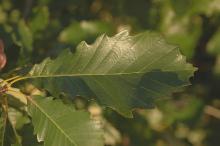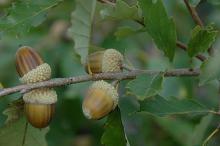Quercus prinoides
Common name:
Dwarf Chinquapin Oak
Dwarf Chestnut Oak
Scrub Chestnut Oak
Pronunciation:
kwer-KUS
Family:
Fagaceae
Genus:
Synonyms:
Quercus prinoides var. prinoides
Type:
Broadleaf
Native to (or naturalized in) Oregon:
No
- Deciduous shrub, sometimes spreading, wide variation in height given, from 1.5 to 20 ft (0.5-6 m) or more. Leaves alternate, simple, lanceolate to oblanceolate or usually obovate, 4-10 cm long and 2-4 cm wide, leathery, base truncate to wedge-shaped (cuneate), margins regularly undulate, toothed or shallow-lobed, teeth usually acute, sometimes rounded, or acute-acuminate, often directed forward, apex short-acute to acuminate, usually 5-8 veins on each side and more or less parallel, glossy dark green above, pale green to tawny below; petiole 7-12 mm long. Fruit (acorns) solitary or paired, cup deeply or shallowly cup-shaped, about 10 deep and 15 mm wide, enclosing 1/4-1/3 of the nut which is light brown, oblong to ovoid, 1.5-2 cm.
- Sun
- Hardy to USDA Zone (4) 5 Native range extends from Maine to Minnesota, south through Nebraska to Texas, east to Alabama, and north to Tennessee and Virginia.
-
Q. prinoides appears similar to and apparently "grades into" Q. muehlenbergii and the "question always arises as to were to exactly draw the line between them" (Stephens, 1973, p. 122). In this regarde, the following is from Flora of North America (www.eFloras.org):
- "The debate over whether Quercus prinoides is distinct from Q . muhlenbergii has continued for most of the last century. Little doubt can exist that strong genetic differences, as expressed by characteristics of habit, leaf form, and habitat preference, separate the two taxa; the question is merely whether they are best treated as subspecies or varieties or as separate species. Over most of the eastern United States, the two taxa occur sympatrically over broad areas with little immediate contact (syntopy), because Q . muhlenbergii is found on calcareous soils and Q . prinoides occurs on sands (often acidic) and dry shales. Seedlings of Q . prinoides can flower and produce acorns in as few as 3-5 years from planting, when only 20-50 cm, and maintain their dwarf, clonal habit in cultivation. Quercus muhlenbergii begins fruiting as a small tree of 3 m or more in height. Because of these differences, and interdigitating geographic distributions, the two taxa seem to be similar in pattern of variation and interaction to other closely related oak species of eastern North America, and dissimilar in pattern to infraspecific taxa such as we see in Q . sinuata var. sinuata and Q . sinuata var. breviloba. The populations that are difficult to determine are usually small scrubby trees, probably mostly Q . muhlenbergii, stunted because of less than favorable moisture conditions, with or without indications of introgression from Q . prinoides".







